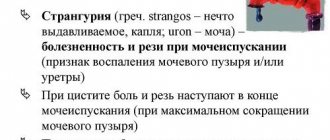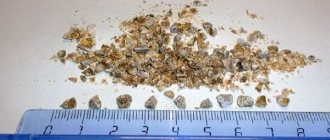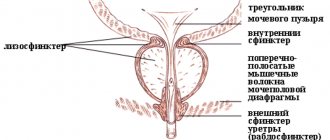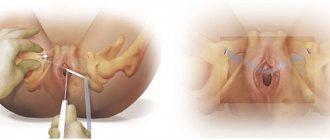Causes of urination at night
Most often this is one of the main symptoms of prostatitis or prostate adenoma.
Night urges with prostate adenoma
An adenoma is a benign growth of the prostate gland. Adenomatous nodes put pressure on the urethra, which causes a frequent urge to urinate. In this case, the ureter is usually weak or intermittent. In advanced cases, bedwetting is possible.
The main danger of adenoma is that symptoms begin to appear only at stage 2 . And at stage 3, many men are faced with the need for complex surgery.
That is why it is important to start treatment at stages 1-2 of adenoma.
Night urges with prostatitis
Prostatitis is inflammation of the prostate gland. The acute phase of the disease is characterized by scanty urination, accompanied by pain, pain and burning.
In the absence of adequate treatment, the acute phase quickly becomes chronic.
The complexity and unpleasantness of chronic prostatitis is that it periodically worsens, causing a man severe pain.
Pain and burning when urinating
Causes of acute pain when urinating
Acute cystitis
This is the most common genitourinary infection among women: its frequency is 0.5-0.7 episodes per woman per year. Due to anatomical features, women suffer from cystitis 30 times more often than men. Pregnancy and postmenopause further increase these chances[4].
Cystitis is an inflammation of the mucous membrane of the bladder, most often it is infectious in nature and can be triggered by hypothermia, poor hygiene, sexual contact, etc.
With this disease, the patient experiences many difficulties associated with going to the toilet. Pain in the bladder, pain when urinating, bloody and/or purulent discharge in the urine, constant unproductive urge to go to the toilet. No matter how cystitis manifests itself, antibiotics that can cope with the source of inflammation are usually prescribed for its treatment. Along with the disease, pain in the bladder, discomfort when urinating, and pain after urinating recede.
Urethritis
This is a disease similar in etiology and symptoms. Its main symptom is painful urination, with pain occurring directly in the urethra itself. Along with it, mucous discharge from the urethra occurs. The disease can occur in acute and chronic form.
In the first case, when urinating, the pain is unbearable, but the painful sensations, subsiding somewhat, can persist the rest of the time. In the second, as a rule, only a slight burning sensation occurs when urinating. One way or another, before the inflammation spreads to the bladder, prostate gland and does not lead to serious complications, you need to consult a doctor.
Urolithiasis disease
This is the most common reason for urological emergency hospitalizations. With it, stones (calculi) form in the organs of the urinary system - kidneys, ureters, bladder - that can interfere with the normal outflow of urine, as well as provoke discomfort when urinating. This is a serious disease that can even lead to unfavorable outcomes. At the slightest suspicion of the presence of stones, you should immediately consult a doctor. After diagnosis, both drug and surgical treatment can be prescribed.
Sexually transmitted diseases
In addition, a significant proportion of complaints of painful urination lead to the identification of sexually transmitted infections. Chlamydia, trichomoniasis, gonorrhea and many other diseases manifest themselves primarily through discharge from the genitals and discomfort when urinating. Burning, pain and itching, redness and rashes in the perineum are a reason to be examined for the presence of the causative agent of these infections. In addition, itching during and after urination can occur with candidiasis, known to many as thrush. Such diseases can cause natural embarrassment, but hiding them or trying to cure them with “folk” remedies is a bad idea and can lead to serious complications. Having tests followed by further treatment from a specialist is a much more reasonable approach.
Tumors of the genitourinary tract
The growth of a tumor inside the urethra or bladder may be accompanied by constant pain when urinating. It may be a benign polyp or a malignant neoplasm.
Postmenopausal changes
Urogenital aging causes the appearance of unpleasant symptoms from the genitourinary tract: pain and pain when urinating, leakage of urine, increased urge to urinate, including at night. This is a consequence of atrophic processes in the mucous membrane of the urogenital tract, the muscular and ligamentous apparatus of the small pelvis [5].
Consequences of going to the toilet at night
Night urination in itself significantly impairs quality of life. Constant interruption of sleep causes fatigue and irritation, and reduces performance.
In addition, if left untreated, complications occur and the disease worsens. For example, prostate adenoma can degenerate into a cancerous tumor. And prostatitis can lead to male infertility.
Self-medication in this case is completely excluded. It can only aggravate the situation and negatively affect the functioning of internal organs. Therefore, if you have regular urges at night, you should be examined by a urologist-andrologist and undergo the necessary tests.
Causes of urinary incontinence in men
Incontinence is much more common in women because it occurs as a result of pregnancy and childbirth. This problem in men occurs more often with age and is caused by diseases of the prostate gland, pathologies that affect the nervous system, and injuries. There are three main types of incontinence:
- Stress urinary incontinence. Occurs when pressure inside the bladder increases from heavy lifting, coughing or sneezing. High blood pressure can cause urine to leak;
- Urgent urinary incontinence. Characterized by the inability to control the urge to urinate;
- Urinary incontinence due to bladder overflow. With this type of disease, urine leaks in small quantities even in the absence of calls to urinate.
The causes and treatment of the problem are closely interrelated. Prostate diseases are the most common prerequisites for the appearance of pathology in older men. The prostate is located under the bladder, around the urethra. As you age, it increases in size and begins to affect the flow of urine.
Additionally, common causes of incontinence in men include difficulties with nerve and muscle control. Anything that affects the nerve or muscle function of the sphincter causes problems with urine control. Other prerequisites for the appearance of the symptom are:
- Benign prostatic hyperplasia;
- Surgical intervention on the prostate gland;
- Diabetes;
- Stroke;
- Neurological diseases;
- Spinal injury;
- Temporary causes of incontinence. Examples include drinking too much caffeine or alcohol, constipation, having a urinary tract infection, depression, and taking certain medications.
Diagnosis and treatment of dysuria at the Yauza Clinical Hospital
To find out the true cause of urinary disorders, the urology department of the Yauza Clinical Hospital conducts a full range of laboratory and instrumental studies. This may include bacteriological examination of urine and genital discharge, cystoscopy, survey and excretory urography, retrograde urethrography. An ultrasound of the genitourinary system is mandatory.
Therapy for urinary disorders involves an integrated approach and is aimed at treating the underlying disease. The urologist will prescribe medications that can normalize the act of urination and recommend physical therapy methods. All of the above violations require an emergency visit to a urologist. In many cases, surgical treatment is indicated.
For an accurate diagnosis, it is necessary to undergo an examination. The modern equipment that the clinic is equipped with will allow this to be done quickly and efficiently. An accurate diagnosis is the key to success in treatment. Sign up for a clinic at a time convenient for you and stay healthy.
You can see prices for services
Interpretation of uroflowmetry results
Uroflowmetry is necessary to obtain a number of parameters that can indicate the presence of pathologies. The result of uroflowmetry is determined and reflected in the form of a graph.
Main indicators of analysis, their norm and interpretation:
- The average rate of urine excretion (V avg.) is the average value of urine flow rates at different intervals of urination. Establishing an average value is necessary because the process itself may be intermittent.
Norm V avg. may depend on gender and age (for example, in middle-aged women the value is slightly lower):
Table of values for the average rate of urination (V average in ml/s):
| Age (years) | Men | Women |
| 4–7 | 10 | 10 |
| 8–13 | 12 | 15 |
| 14–45 | 21 | 18 |
| 46–65 | 12 | 18 |
| 66–80 | 9 | 18 |
- voiding time - the time interval between the beginning and end of emptying the bladder. You can decipher the results by knowing the exact amount of fluid consumed and, accordingly, the volume of urine released. For analysis, it is optimal to consume up to 1 liter of water (usually 200-500 ml);
maximum volumetric flow rate of urination. This parameter should not be measured at the very beginning of urination, but after a few seconds. Normal up to 40 years: 15-18 ml/sec (men) and 20-25 ml/sec (women). With age, the normal values decrease. Deviations from the norm in a larger direction, as a rule, indicate a neurogenic bladder. A decrease in the indicator indicates obstructive disorders in the cervical region;- time to reach maximum urination rate. The norm varies from 4 to 9 seconds. As a rule, an increase in time is a consequence of detrusor weakness or narrowing of the urethral lumen;
- the waiting time for the start (the process of urine excretion) is normally within 10 seconds. Sometimes it can be increased to 30-40 seconds (due to psychological factors). Excessively long waiting times may indicate organic damage to the muscle layer of the bladder.
Deciphering the results of the procedure is possible by analyzing the uroflowmetry graph. The graph normally represents a dome with a pronounced 1 peak. This peak reflects the maximum rate of urine output.
You need to decipher the graph curve as follows:
- a long curve with a low maximum speed indicates a blockage at the level of the excretory organ or urethra. Most often these obstructive disorders are minor;
- the peak of the curve is shifted to the left, the line of the curve is uneven, and the maximum speed is low - sclerotic changes are possible at the level of the cervix. An uneven line indicates pressure surges in the urine stream;
- the graph does not have a pronounced peak, but instead a plateau (flat line). The rate of urination is approximately the same throughout the entire process. These parameters are characteristic of urinary tract stricture;
- the presence of 2 peaks in the graph is evidence of a violation of the coordination of the functioning of the bladder detrusor and sphincter;
- the appearance of several peaks on the graph and frequent interruption of the urine stream are a consequence of a violation of the vesical innervation. The presence of several peak values is a consequence of contractions of the abdominal muscles;
- a sharp and high peak on the graph, as well as a high rate of urination in a short period of time - urinary incontinence. This disorder is most often associated with sphincter dysfunction.








